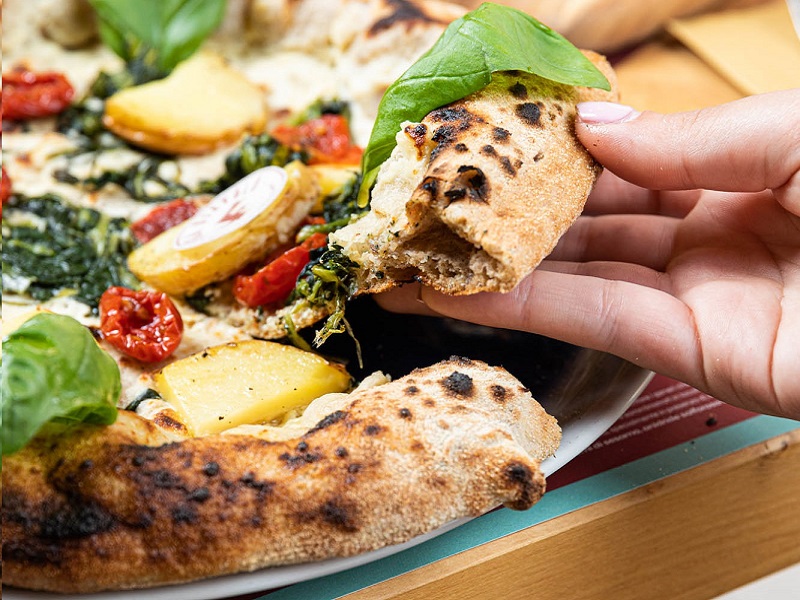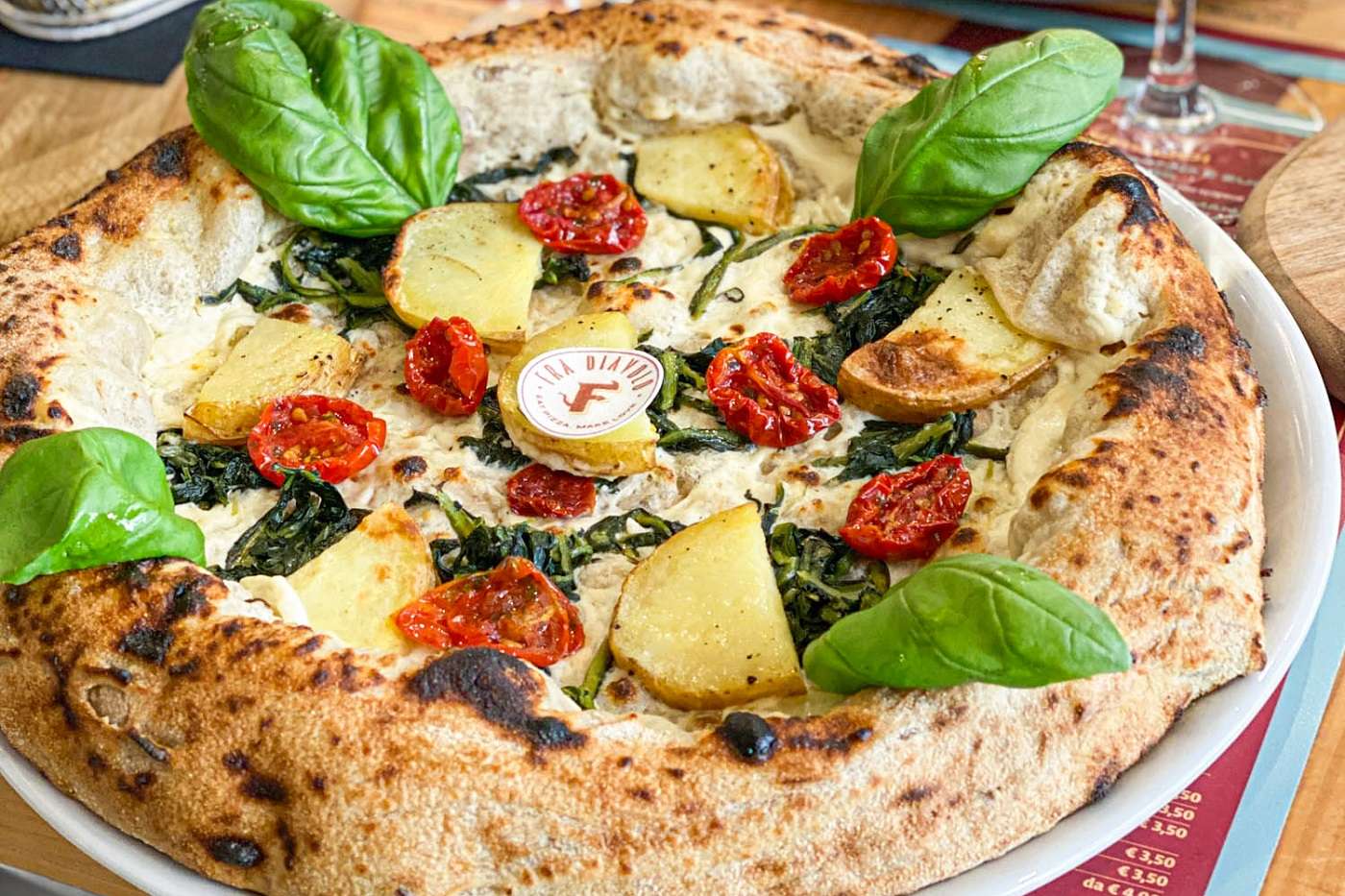ALL THE PROPERTIES AND CALORIES OF PIZZA DOUGH WITH MULTIGRAIN FLOUR
Pizza is a delicious and super-versatile dish, which we have learned to enjoy in all sorts of ways, embracing continuous flavour experimentation. Rich in fibre and flavour, rustic, crispy and highly digestible: have you ever been enchanted by the smell of a multi-grain pizza?
We at Pizzzeria Fra Diavolo can't wait to tell you everything you need to know about this contemporary speciality and we are ready to reveal why it is the most democratic compromise with your fitness requirements. Let's start!
What are cereals?
Cereals represent a wide variety of agricultural products used for food purposes, and are particularly popular in our kitchens because of their versatility and important role in a balanced Mediterranean diet. By processing and milling the edible parts of these herbaceous plants, the endosperm, bran and germ, we obtain essential ingredients for our diet. The most common example? Flour! But what are the most common types of cereals on our tables and what important properties do they have?
Types of cereals: did you know that wheat is the most common cereal in Italy?
The cereal family is very rich and each one retains its own peculiarities, both from a nutritional point of view and in terms of use. Although most are used in human nutrition, some poor grains such as millet, oats and sorghum are mainly used as a food for livestock. Let's take a closer look at the most common cereals on our tables:
- wheat
- maize
- barley
- rice
- spelt
- rye
- oats
- teff
- mile
- sorghum
The most widespread cereal in Italy is wheat, which finds favourable conditions for flourishing in our latitudes, followed by maize, barley and rice (which we know loves particularly humid climates). In addition to the cereals seen so far, there are pseudo-cereals such as quinoa, buckwheat and chia: despite their similarities, these plants belong to a different botanical family and, in most cases, are characterised as gluten-free foods.
Characteristics of cereals
The properties of cereals are also increasingly appreciated in a good pizza , and the reason is easily explained! Generally, cereals are rich in carbohydrates, vitamins, minerals and starch, an important source of energy, and have a fair protein and fat content, making them a suitable food for a balanced daily diet.
To get the most out of the benefits of cereals, it is often recommended to vary between different types, as each one has its unique nutritional characteristics. This is the case with spelt, one of the favourite ingredients in our pizza makers' recipes: cholesterol-free, rich in vitamins A, C and B, and minerals such as iron, phosphorus and magnesium!
Multi-grain flour for pizza: what it is and what it contains
Now that we have discovered together how many and which types of cereals are generally cultivated in our country, we still need to discover one of the main ingredients of a true multigrain pizza: flour.
Multi-grain flour is the mix of different flours resulting from the milling of several cereals, and is the best choice to benefit fully from the many nutrients in the individual seeds and flakes.
The heterogeneous combination of ingredients is carefully studied in order to keep the nutritional content of the semi-finished product balanced and to offer the most intense and pleasant taste possible!

Cereal flour, wholemeal flour or white flour: what's the difference?
Let's get this straight! Unlike multigrain flour, which is made from several varieties of cereals, wholemeal flour is a food product that is obtained by grinding only common wheat, generally cleaned of foreign matter and impurities. The wholemeal nature of this flour derives from the fact that all the components of the seed are used in the processing, whereas white flour is limited to the endosperm, which is bleached using food additives. While the nutritional value of multigrain flour may vary depending on the flour mix it is made of, the nutritional values of 100 g wholemeal wheat flour are as follows:
- Water 13.4 g
- Energy 313 kcal
- Protein 11.9 g
- Lipids 1.9 g
- Available carbohydrates 61.8 g
- Starch 54.3 g
- Cholesterol 0 mg
- Soluble sugars 2.1 g
- Total fibre 8.4 g
- Soluble fibre 1.92 g
- Insoluble fibre 6.51 g
- Potassium 337 mg
- Sodium 3 mg
- Phosphorus 300 mg
- Calcium 28 mg
- Iron 3 mg
In contrast, 00 wheat flour is slightly higher in calories (323 kcal per 100 g) and richer in carbohydrates, at the expense of less fibre.
Pizzeria Fra Diavolo multi-grain pizza dough
We at Fra Diavolo have always been attentive to innovation, quality and experimentation, to offer you a unique contemporary pizza served with the best gourmet toppings. We cultivate our love of craftsmanship and attention to raw materials right from the choice of dough: did you know that one of our specialities is pizza with multi-grain flour? Our Neapolitan pizza is made with a special multigrain dough, prepared using a light mix of 00 flour to which we add spelt, whole wheat flour and mixed whole grains. Let's discover its properties, calories and ingredients!
FANCY A GOURMET PIZZA? DISCOVER OUR MENU
Properties of multigrain pizza base
The Neapolitan multi-grain pizza is a must-have for anyone looking for a light and crispy taste experience with a delightfully rustic aroma.
Its special cereal mixture creates a unique dish rich in protein, fibre and minerals.
The benefit that makes it particularly popular with light foodies? Its high digestibility! In addition, the higher the percentage of fibre in the dough, the greater its function in limiting the absorption of fats and sugars, which in turn lowers blood sugar levels.

A multigrain pizza has only 570 calories
Unlike a classic pizza, a multigrain pizza is very rich in fibre and protein and has a slightly lower calorie count than a classic pizza. With an average weight of 250 g, a multigrain pizza contains around 570 kcal, while a classic margherita pizza consumed in the same quantities has an average of 675 kcal. Finally, the multi-grain dough is slightly more caloric than a charcoal pizza.
This type of dish lends itself very well to both hot and cold toppings: the latter increase the calories of the pizza and choosing seasonal vegetables will certainly help to make it lighter. If you follow a healthy, balanced diet, we recommend you opt for lighter seasonings!
Have you already had a look at our stores? Discover the Fra Diavolo pizzeria nearest to you and visit us!


Registered office via mazzini, 60 a - Torino 10123 - italia






